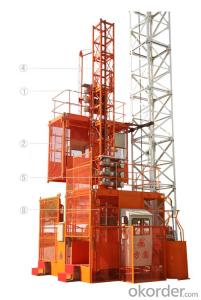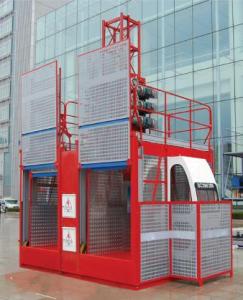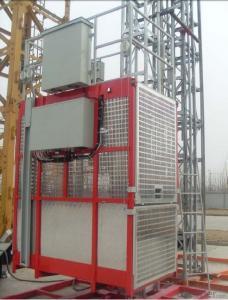Building hoist SC100/100 Best quality Construction Machinery
- Loading Port:
- Qingdao
- Payment Terms:
- TT or LC
- Min Order Qty:
- 1 unit
- Supply Capability:
- 15 unit/month
OKorder Service Pledge
OKorder Financial Service
You Might Also Like
construction hoist description:
The construction hoist has achieved internationally advanced level in terms of industrial design, control and the drive performance, as well as the operation safety and comfortableness. And Fangyuan is also making efforts to keep improving the product, as what the construction hoist lifts is not only people and material, but also a kind of social responsibility and service concept…
The new generation SC series of construction hoists adopt modular structure, ergonomic design and advanced manufacturing technology, thus the adaptability and reliability of the product is greatly improved, e.g. the max. lifting height can reach 300 meters. The product adopts multiple patented technologies, reaches advanced level in China, and the market share in domestic market is increasing year by year. The product has also been exported to overseas countries like Russia, Turkmenstan, Vietnam, etc. winning the confidence of customers of both home and abroad
1. The cage drive system is equipped with buffering device, so the cage moves more stable.
2. The ergonomically designed cage interior improves comfortableness.
3. The unique structural design has applied for patent.
4. The typical technologies ensure the malposition difference of the guide rail.
5. The excellent parts in the industry ensures reliable quality of the machine.
6. Precise assembly and accurate drive.
7. Professional solutions for special projects.
8. The complete safety devices ensures reliable control system.
The built-up hoist will be much more expensive, but will also be easier to repair and more durable. Package units were once regarded as being designed for light to moderate usage, but since the 60s this has changed. Built-up units are designed for heavy to severe service, but over the years that market has decreased in size since the advent of the more durable packaged hoist. A machine shop or fabricating shop will use an integral-package hoist, while a Steel Mill or NASA would use a built-up unit to meet durability, performance, and repairability requirements. NASA has also seen a change in the use of package hoists. The NASA Astronaut training pool, for example, utilizes cranes with packaged hoists.
Construction Hoists Specification:
SC series product also has special design, such as reinforced guide rail with cross-section of 800mm, inclined type, special for cooling tower, etc. All the double cage construction elevator can be changed into single cage type, such as SCD200.
Model | SC200/200 | SC200/200BP | SCD200/200 | SC200/200B | ||
Configuration | Standard type | Frequency conversion | Counterweight type | Export type | ||
Rated load | kg | 2000/2000 | 2000/2000 | 2000/2000 | 2000/2000 | |
Cage size L×W×H | m | 3×1.3×2.2 | 3×1.3×2.2 | 3×1.3×2.2 | 3×1.3×2.2 | |
Passengers | 16/16 | 16/16 | 16/16 | 16/16 | ||
Max.lifting height | m | 150 | 300 | 150 | 150 | |
Max.height of free end | m | 9 | 9 | 9 | 9 | |
Lifting speed | m/min | 33 | 0~60 | 33 | 33 | |
Capacity of small hoist | kg | 200 | 200 | 200 | 200 | |
Std.section L×W×H | mm | 650×650×1508 | ||||
Electric motor | Type | Disc brake electic motor | ||||
Power | kW | 11×3/11×3 | 11×3/11×3 | 11×2/11×2 | 11×3/11×3 | |
Speed limiter | Action speed | m/s | 1.2 | 1.45 | 1.2 | 1.2 |
Rated brake load | kN | 40 | 40 | 30 | 40 | |
Model | SCD200/200B | SC100/100 | SCD200 | ||
Configuration | Counterweight type | No counterweight | Counterweight type | ||
Rated load | kg | 2000/2000 | 1000/1000 | 2000 | |
Cage size L×W×H | m | 3×1.3×2.2 | 3×1.3×2.2 | 3×1.3×2.2 | |
Passengers | 16/16 | 12/12 | 16 | ||
Max.lifting height | m | 150 | 150 | 150 | |
Max.height of free end | m | 9 | 9 | 9 | |
Lifting speed | m/min | 33 | 33 | 33 | |
Capacity of small hoist | kg | 200 | 200 | 200 | |
Std.section L×W×H | mm | 650×650×1508 | |||
Electric motor | Type | Disc brake electic motor | |||
Power | kW | 11×2/11×2 | 11×2/11×2 | 11×2 | |
Speed limiter | Action speed | m/s | 1.2 | 1.2 | 1.2 |
Rated brake load | kN | 30 | 30 | 30 | |
Construction Hoist Images:
The above parameters are subject to change without prior notice, please refer to the actual product.
Note: Both cage size of 3×1.3×2.2 and 3.2×1.5×2.4 are available for of each model (Excl. export type).



FAQ of Building Hoist:
Q: What is the building hoist main purpose?
A: Building hoist equipped with double or single cabin to transport the materials and labors up and down. It's the ideal construction equipment for vertical transportation in the field of construction.
Q: What is the main structure of building hoist?
A: The P/M construction hoist mainly contains metal structure, driving system, electrical control system, cable guide & protection system, electrical top crane and safety device.
Q: What is the meaning of the building hoist’s code?
A: Take SC200/200 for example: “SC” stands for rack and pinion hoist, “200/200” stands for double cage and capacity is 2 tons per cage. “SC200” stands for single cage and capacity is 2 tons.
Q: What is the dimension of the cage?
A: Normally the cage dimension is 3X1.5X2.5M (L/W/H) for 2t type hoist. Details should be checked according to our quotation sheet. Also, the size can be customized according to the factual site condition. There are two doors (entrance & exit doors) for each cage, It can be produced as up & down sliding or ramping model for safety and convenience.
- Q: Does the misuse or incorrect use of lifting equipment pose a risk of injury to workers?
- <p>Yes, improper or incorrect use of lifting equipment can cause serious injury to workers. This can include accidents such as dropping loads, which can lead to crushing injuries or being struck by falling objects. Additionally, improper lifting techniques can lead to musculoskeletal injuries, such as back strains or sprains. It's crucial for workers to be trained in the safe operation of lifting equipment and to follow all safety protocols to minimize the risk of injury.</p>
- Q: This question asks for the method to determine the maximum weight that a building hoist can safely lift.
- <p>To calculate the lifting capacity of a building hoist, you need to consider several factors. First, identify the hoist's rated capacity, which is usually specified by the manufacturer. This is the maximum weight the hoist is designed to lift. Next, assess the condition of the hoist, including any wear and tear that might affect its performance. Check the hoist's mechanical components, such as cables, pulleys, and motors, to ensure they are in good working order. Additionally, consider the weight of the load you intend to lift and any additional factors like the frequency of lifts or the height of the lift. Always operate within the hoist's rated capacity and follow safety guidelines to prevent accidents.</p>
- Q: The difference between the derrick and the construction elevator?
- Derrick is with the hoist rope hoisting, referred to as goods for SSB100 type, with construction lifter model does not allow the manned, deadweight is one tons, construction lifter is said cargo amphibious ladder, with gear and rack driving, weight is 2 tons, you can have a look at the GB/T 10054-2005, the construction lifter, with clear rules.
- Q: This question asks about the process of changing the speed of a building hoist, which is a device used in construction to lift materials.
- <p>Adjusting the speed of a building hoist typically involves accessing the hoist's control panel or motor settings. For electric hoists, this may include adjusting the frequency of the power supply through a variable frequency drive (VFD), which alters the speed of the motor. For manual hoists, speed adjustments might involve changing the gear ratio or the tension on the hoisting rope. Always refer to the hoist's user manual for specific instructions, as different models have different mechanisms. Safety should be a priority; ensure that any adjustments are made by trained personnel and in compliance with safety regulations.</p>
- Q: Where is the location of the elevator in the project
- The position of construction elevator is usually set in the project to facilitate access to material, material handling and personnel up and down, not affecting the construction process.
- Q: This question asks if a building hoist can be utilized for lifting both light and heavy objects.
- <p>Yes, a building hoist can be used for lifting both light and heavy objects. It is designed to handle a wide range of weights, depending on its capacity. Building hoists are engineered to lift materials such as bricks, concrete, and steel beams during construction. However, it's crucial to ensure that the hoist's lifting capacity is not exceeded to avoid accidents. Always check the manufacturer's specifications and safety guidelines before lifting any object with a building hoist.</p>
- Q: This question asks for guidelines on the safe operation of a building hoist, a device used to lift materials in construction.
- <p>To use a building hoist safely, follow these guidelines: Ensure the hoist is properly installed and inspected by a qualified person. Never exceed the hoist's weight limit. Keep the hoist area clear of obstacles and ensure all safety devices are functioning. Do not use the hoist if there are any visible defects or damage. Always secure the load properly and ensure it is balanced. Never leave the hoist unattended while in operation. Use hand signals or a communication system to coordinate with the operator. Regularly inspect and maintain the hoist to prevent accidents. Always follow the manufacturer's instructions and adhere to local safety regulations.</p>
- Q: This question asks about the time required to install a building hoist, a device used for lifting materials in construction.
- <p>The time it takes to install a building hoist can vary significantly based on factors such as the type and size of the hoist, the specific building requirements, and the experience of the installation team. On average, it can take anywhere from a few hours to a couple of days. For smaller hoists, installation might be completed within a day, while larger, more complex systems could take longer. It's important to note that safety checks and regulatory compliance verifications are also part of the process, which can add to the total installation time.</p>
- Q: Construction site construction elevator and tower crane, which unit security check and acceptance?
- The inspection, inspection, inspection and acceptance of the inspection station shall not be put into operation
- Q: This question asks whether a building hoist can be used in both indoor and outdoor construction settings.
- <p>Yes, a building hoist can be used both indoors and outdoors for construction work. These hoists are versatile and designed to facilitate the movement of materials and personnel in multi-story buildings. Outdoors, they are often used during the construction of high-rise buildings, while indoors, they can be used for the vertical transportation of materials in large structures like shopping malls or office buildings. It's important to ensure that the hoist is suitable for the specific conditions, such as weather resistance for outdoor use, and that safety protocols are strictly followed to prevent accidents.</p>
Send your message to us
Building hoist SC100/100 Best quality Construction Machinery
- Loading Port:
- Qingdao
- Payment Terms:
- TT or LC
- Min Order Qty:
- 1 unit
- Supply Capability:
- 15 unit/month
OKorder Service Pledge
OKorder Financial Service
Similar products
Hot products
Hot Searches
Related keywords
































